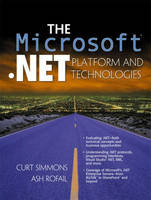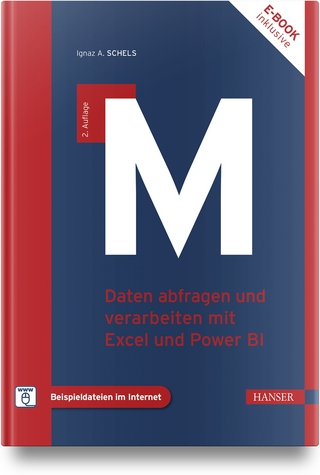
The Microsoft .NET Platform and Technologies
Prentice Hall (Verlag)
978-0-13-034178-5 (ISBN)
- Titel ist leider vergriffen;
keine Neuauflage - Artikel merken
Microsoft .NET Platform and Technologies is the complete guide to Microsoft's .NET initiative for both IT professionals and business decision-makers. Curt Simmons and Ash Rofail explore the goals and design of the .NET framework, the Microsoft technologies that enable it, what .NET means to the Internet, and what it can (and cannot) offer your business. If you need to make intelligent decisions about .NET, this is the to-the-point, up-to-the-minute briefing you've been searching for. The authors begin by exploring the foundational concepts that underlie the .NET platform. They present a high level overview of .NET's goals and processes, introducing the new Web services .NET is intended to support, and showing how businesses can use them for competitive advantage. They walk through the .NET framework, its protocols and programming interfaces, introduce the Visual Studio.NET programming environment, and explain the central role of XML in .NET and Microsoft's approach to Web services delivery. In Part Two, the authors review Microsoft's key .NET Enterprise servers, showing how they work and how they function within the .NET initiative.
CURT SIMMONS is an author and technical trainer specializing in Microsoft operating systems, BackOffice products and Internet technologies. A Microsoft Certified Systems Engineer (MCSE) and Microsoft Certified Trainer (MCT) based in Dallas, TX, his books include Configuring Windows 2000 Server (Prentice Hall PTR). ASH ROFAIL is Chief Technology Officer of User Technology Associates (UTA, Inc.) a consulting firm in Northern Virginia. The author of several books and articles on Microsoft-based Technologies and XML, Rofail is a frequent conference speaker who also teaches at universities throughout the United States.
Preface.
I. MICROSOFT .NET COMPONENTS AND ARCHITECTURE.
1. Introduction to Microsoft .NET.
Defining .NET. .NET Goals. .NET Services. How .NET Affects the IT Professional. How .NET Affects the User. The Loose Coupling of Web Services. .NET Infrastructure. Common Language Runtime. Unified Programming Classes. ASP.net. Summary. Q&A.
2. .NET and E-Business.
Data Interaction. E-Business and Data. Customers and Data. Business-to-Business E-Commerce. Customer-to-Business E-Commerce. .NET and Small Business. Windows and .NET. .NET Business Model Impact. Summary. Q&A.
3. The .NET Platform.
Web Services and the Internet. The .NET Framework. .NET Runtime Architecture. Inside the .NET Framework. The Common Language Runtime. Inside the Common Language Runtime. Summary. Q&A.
4. Moving from COM to .NET.
Managed Code. COM to .NET Terminology Mapping. Object Activation and .NET Runtime. Summary.
5. Understanding and Working with XML.
Creating XML. Brief History of ADO. ADO 2.5 and Stream Persistence. Integrating ADO XML with the XML DOM. Hierarchical Recordsets. Parsing XML. Binding XML. Binding XML with DSO. Binding with Script and the DOM. XML Data Islands. Summary.
6. Understanding ASP.NET.
Improvements over ASP. New ASP.NET Features. Components of an ASP.NET Application. Inside an ASP.NET Application. Web Forms. Web Controls. Custom Controls. Data Bound Controls. Caching Enhancements. ASP.NET Libraries. Deploying ASP.NET Applications. Summary.
7. Understanding and Working with Web Services.
Transition. Endings. Neutral Zone. Beginnings. Evolution of Architecture. How Will Web Services Work? Evaluating Current Technologies. Web Services Core Technologies. Building a Web Service. Calling a Web Service. Business Investment. Impacts on Business. Cash Flow Analysis. Summary.
II. MICROSOFT .NET SERVERS.
8. Microsoft BizTalk Server.
Why BizTalk Server is Important to Enabling B2B Exchange. BizTalk Server Installation Requirements. What Does BizTalk Server Do? BizTalk Server Orchestration Engine. Exploring BizTalk Server Components. BizTalk Server. BizTalk Management Desk. Editor. Mapper. Application Designer. Summary. Q&A.
9. Microsoft Commerce Server 2000 and Microsoft Host Integration Server 2000.
Why Commerce Server 2000 Is Important. BizTalk Server Installation Requirements. Examining Commerce Server Concepts. Site Management Cycle. Profiles. Cookies. Catalogs. Campaigns. Data Warehouse. Analysis. Pipeline. Exploring Commerce Server 2000 Tools. Commerce Server Manager. Site Packager. Pipeline Editor. Business Desk. Host Integration Server. Why Host Integration Server Is Important. Using Host Integration Server. Features of Host Integration Server. Summary. Q&A.
10. Microsoft Application Center Server 2000.
Why Application Center Service Is Important. Application Center Server Installation Requirements. The Basics of How Application Center Server Works. Application Center Management. Cluster Creation and Management. Understanding Synchronization. Application Deployment. Health Monitor. Summary. Q&A.
11. Microsoft Internet Security and Acceleration Server.
The Importance of ISA in a Distributed Application Architecture. ISA Server Requirements and Installation Options. The Basics of How ISA Server Works. Understanding ISA Server Arrays. Understanding Acceleration. Cache Drives. Cache Configuration. Distributed Caching. Chained Caching. Managing Client Access and Functionality. Site and Content Rules. Protocol Rules. Bandwidth Rules. Firewall Capabilities. ISA Server System Security. Packet Filtering. Intrusion Detection. Firewall Chains. Application Filters. Publishing Rules. ISA Server Clients. H. 323 GateKeeper. Monitoring and Alerts. Summary. Q&A.
12. Microsoft Exchange Server 2000.
The Role of Exchange Server in the Architecture of an Enterprise Application. Active Directory Integration. Multiple Messaging Database and Web Storage. Flexible Administrative Model. Other Features. Exchange Server 2000 Installation Requirements. Exchange Management. Active Directory Users and Computers. Exchange System Manager. Migration Wizard. Active Directory Cleanup Wizard. The Active Directory Connector. Using the ADC. Summary. Q&A.
13. Microsoft SQL Server 2000.
Why SQL Server Is Important. SQL Server 2000 Components. SQL Server 2000 Installation Requirements. What's New in SQL Server 2000. SQL Server Architecture Features. Client/Server Architecture. Database Architecture. Relational Database Engine Architecture. Administration Architecture. Replication Architecture. SQL Server Tools and Administration. Enterprise Manager. Server and Client Network Utilities. SQL Server Profiler. Query Analyzer. Service Manager. Analysis Services. SQL Server 2000 and the Web. IIS Integration with SQL Server Architecture. IIS Virtual Directory Management. Creating XML with SQL Server 2000. XML Templates. Writing XML Data. Summary. Q&A.
14. Microsoft Mobile Information Server and Microsoft SharePoint Portal Server.
Why is Mobile Information Server Important? How Mobile Information Server Works. Features of Mobile Information Server. Device Freedom. Mobile Standards. Scalable. Active Directory Integration. Mobile Information Server Edition. Mobile Information Server and Security. What to Expect. SharePoint Portal Server. Portal. Web Based Document Management. Indexing and Searching. SharePoint Portal Server Requirements. SharePoint Portal Workspaces. Sharepoint Portal Server Management. Summary. Q&A.
Appendix A: Microsoft Windows 2000 Server and Active Directory Primer.
Appendix B: MMC Primer.
Index.
| Erscheint lt. Verlag | 21.11.2001 |
|---|---|
| Verlagsort | Upper Saddle River |
| Sprache | englisch |
| Maße | 179 x 235 mm |
| Gewicht | 513 g |
| Themenwelt | Informatik ► Betriebssysteme / Server ► Windows |
| Mathematik / Informatik ► Informatik ► Netzwerke | |
| ISBN-10 | 0-13-034178-9 / 0130341789 |
| ISBN-13 | 978-0-13-034178-5 / 9780130341785 |
| Zustand | Neuware |
| Haben Sie eine Frage zum Produkt? |
aus dem Bereich


